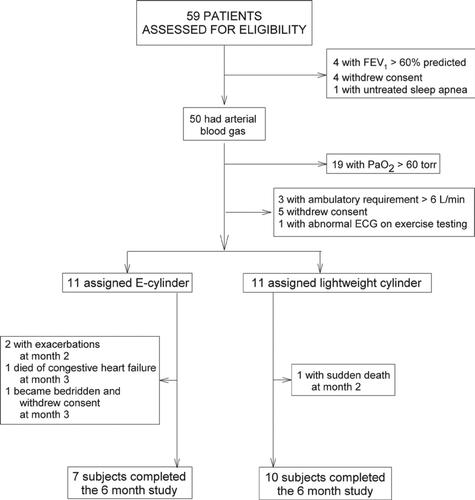Abstract
Lightweight ambulatory oxygen devices are provided on the assumptions that they enhance compliance and increase activity, but data to support these assumptions are lacking. We studied 22 patients with severe chronic obstructive pulmonary disease receiving long-term oxygen therapy (14 men, average age = 66.9 y, FEV1 = 33.6%pred, PaO2 at rest = 51.7 torr) who were using E-cylinders as their portable oxygen. Subjects were recruited at 5 sites and studied over a 2-week baseline period and for 6 months after randomizing them to either continuing to use 22-lb E-cylinders towed on a cart or to carrying 3.6-lb aluminum cylinders. Utilizing novel electronic devices, ambulatory and stationary oxygen use was monitored continuously over the 2 weeks prior to and the 6 months following randomization. Subjects wore tri-axial accelerometers to monitor physical activity during waking hours for 2–3 weeks prior to, and at 3 and 6 months after, randomization. Seventeen subjects completed the study. At baseline, subjects used 17.2 hours of stationary and 2.5 hours of ambulatory oxygen daily. At 6 months, ambulatory oxygen use was 1.4 ± 1.0 hrs in those randomized to E-cylinders and 1.9 ± 2.4 hrs in those using lightweight oxygen (P = NS). Activity monitoring revealed low activity levels prior to randomization and no significant increase over time in either group. In this group of severe chronic obstructive pulmonary disease patients, providing lightweight ambulatory oxygen did not increase either oxygen use or activity. Future efforts might focus on strategies to encourage oxygen use and enhance activity in this patient group. This trial is registered at ClinicalTrials.gov (NCT003257540).
Introduction
Long-term oxygen therapy (LTOT) is considered standard of care for hypoxemic chronic obstructive pulmonary disease (COPD) patients because it decreases mortality (Citation1, 2). In addition to stationary devices, LTOT includes portable devices that provide oxygen outside of the home. Portable devices range from E-cylinders towed on a wheeled cart, weighing approximately 22 lb, to more expensive, lightweight systems that can be carried on the body, weighing less than 5 lb. The rationale for lightweight systems is the assumption that they improve compliance and facilitate ambulation. However, no studies have carefully validated this assumption.
We conducted a randomized controlled trial in which we recruited LTOT patients who were utilizing E-cylinders as their ambulatory supply. After characterization, patients were randomly assigned to continue E-cylinders or to receive a lightweight oxygen supply. Subjects were then monitored for 6 months. We hypothesized that, compared with using E-cylinders, lightweight oxygen devices would increase daily oxygen use and activity level.
Methods
Subjects
Subjects were recruited from 5 sites of the COPD Clinical Research Network; each site's institutional review board approved the study. Subjects gave written consent for participation. Eligible subjects were men or women ≥40 years of age who had not had a COPD exacerbation within the prior 4 weeks. Participants had to be receiving LTOT for ≥6 months during which either no ambulatory supply was provided or the ambulatory source was an E-cylinder. To proceed to randomization, patients also had to have forced expiratory volume in one second (FEV1) ≤60% predicted (Citation3), FEV1 divided by forced vital capacity ≤65% and resting room air arterial oxygen partial pressure (PaO2) measured by blood gas analysis of <60 torr.
Subjects with uncontrolled angina or heart failure, orthopedic, neurologic or cognitive impairments that would limit ambulation, who participated in pulmonary rehabilitation within the previous 3 months, or who were current smokers were excluded. Subjects were also excluded if unable to maintain oxygen saturation ≥92% while receiving 4 L/min of continuous nasal cannula oxygen flow at rest or when oxygen conserver setting was 6 during exercise.
Oxygen use assessment
Ambulatory Oxygen. We utilized a conserving regulator capable of recording oxygen use from compressed gas tanks for 42 days (PD1000M, Devilbiss, Somerset, PA). Conserver triggers (indicating a breath) per minute and minutes/hour in which ≥1 breath occurred were recorded. After a period of use, data were downloaded to a computer.
Stationary Oxygen. A device, designated the “Breath Tracker” (fabricated by Reference LLC, Elkader, IA), utilized a piezoelectric sensor to record pressure fluctuation accompanying breathing. This device was mounted on the stationary concentrator and connected to one lumen of a double lumen 50-foot oxygen cannula commonly employed for home oxygen use. Circuitry processed respiratory pressure fluctuations and recorded breaths/minute for every minute. Memory and battery life allowed 42 days of recording. After retrieval, data were downloaded to a computer.
Activity assessment
We utilized a small (5 × 5 × 1.5cm), lightweight (42.6gm) tri-axial accelerometer (RT3, Stayhealthy, Monrovia, CA) worn on a waist belt and capable of activity recording up to 21 days. This device calculates physical activity, expressed in vector magnitude units (VMU), each minute. Resulting data were downloaded to a computer.
Data analysis
Activity and oxygen utilization data were uploaded to a central website and downloaded for analysis (LA BioMed, Torrance, CA) via secure transmissions. Programs in Excel (Microsoft, Redmond, WA) merged stationary and ambulatory oxygen data. We calculated minutes/hour of stationary and ambulatory oxygen 24 hours/day during baseline and for each post-randomization month. Average oxygen use over the course of a day was calculated from average minutes of oxygen use for each of the day's 24 hours. The activity monitor analysis routines were previously described (Citation4) and determined, for each hour of the day, the fraction of time the activity monitor was worn and, for times the monitor was worn, average VMU/minute.
Oxygen supply
The lightweight supply was an aluminum cylinder with carbon fiber and epoxy overwrap (M06D, Luxfer, Riverside, CA). When filled to 2400 psi, tank, valve and regulator weighed 3.6 lb and, when used with a conserver flow setting of 2, provided ∼6 hours of oxygen. A carrying bag (OxyComfort, Kalispell, MT) was provided allowing the unit to be worn in a shoulder sling.
Study protocol
Before randomization, the clinical coordinator conducted an education session focused on increasing LTOT understanding and encouraging ambulation. Subjects were instructed to use supplemental oxygen 24 hours/day.
Baseline testing included radial artery puncture for blood gas analysis after 10 minutes of rest while breathing air. Resting oxygen prescription was set after 10 minutes of rest by titrating continuous flow oxygen to yield pulse oximeter saturation (SpO2) ≥92%. Oxygen conserver setting was adjusted to yield SpO2 ≥92% while subjects walked on a treadmill at zero grade and comfortable speed (usually 1 mph). Spirometry (Citation5) followed two puffs of albuterol. Total lung capacity (TLC) (by body plethysmography (Citation6)) and single-breath carbon monoxide diffusing capacity (DLCO) (Citation7) were assessed. Incremental exercise testing was performed on a cycle ergometer; subjects respired a 30% oxygen mixture.
Baseline activity and oxygen use were recorded for two weeks during which subjects utilized E-cylinders as their ambulatory supply. Patients were then randomized (stratified by enrollment site) to either continued E-cylinder use or lightweight device use. After randomization, oxygen use was assessed essentially continuously in 1-month epochs, with home visits to collect and replace oxygen recording devices. Activity was monitored for 3 weeks before the 3- and 6-month in-center visits.
Statistical analysis
Desired sample size was 100 patients based on the following assumptions: those receiving lightweight oxygen would increase daily oxygen use by 3 hours, yet oxygen use in those using E-cylinders would not change, SD of daily oxygen use would be 4 hours/day (literature values range from 3–5.2 hours/day (8–11)), 2-sided alpha = 0.05 and power = 0.9.
Intent to treat analysis was employed; for subjects who dropped out, the last post-randomization observation was carried forward. Repeated measures two-way analysis of variance determined whether oxygen use or activity level varied with group assignment or changed from baseline level. The Holm-Sidak test facilitated isolation of significant differences. Pearson product-moment correlations examined oxygen use and activity level predictors. P<0.05 was the significance criterion. Data are presented as mean ± SD unless otherwise specified.
Results
Of 59 subjects screened, only 39% proceeded to randomization (). Importantly, of 50 subjects proceeding to blood gas testing, 38% demonstrated resting room air PaO2 >60 torr. Average PaO2 of non-qualifiers was 68.5 torr; 5 subjects had PaO2 >70 torr. compares characteristics of 19 subjects excluded for high PaO2 with 22 randomized subjects. Randomized subjects had lower PaO2, but were otherwise similar. Interestingly, both subject groups had (by self-report) been receiving LTOT averaging over 3 years and used oxygen >20 hours/day. Most reported starting LTOT during an exacerbation; 41% did not recall being reassessed.
Table 1. Subject characteristics and self-reported oxygen use
After 9 months of recruitment, only 22 patients had been randomized (target was 100), largely because most LTOT patients in our University-affiliated centers were already utilizing lightweight devices and/or were not sufficiently hypoxemic at rest. Accordingly, the Data Safety and Monitoring Board stopped further recruitment but allowed randomized patients to complete their participation. Of 22 subjects randomized, 7 E-cylinder and 10 lightweight cylinder subjects completed the 6-month study ().
Table 2. Characteristics of randomized subjects
Oxygen Use. For those randomized, oxygen prescription was 1.9 ± 1.0 L/min at rest and a conserver setting of 3.8±1.5 during exercise. Illustrative plots in individual subjects of previously unobserved variability in oxygen use pattern over the course of the day are presented in . plots average daily oxygen utilization time course in 22 subjects during the 2-week baseline period. On average, oxygen utilization was excellent during nighttime hours (∼50 minutes/hour) and declined mildly during the day. E-cylinder oxygen use peaked at 1 PM at 12 minutes/hour (20% of the time). On average, subjects used oxygen 19.7 hours/day; 17.2 hours was stationary and 2.5 hours was ambulatory.
Figure 2. Compliance with long-term oxygen therapy in 3 illustrative COPD patients. The abscissa divides each day into one hour bins (starting at midnight (MN)); the ordinate presents the average (± 1SE) minutes of use per hour for ambulatory, stationary and total oxygen use. Panel A averages 28 days of data in the second month after randomization to the lightweight oxygen group. There is good nighttime compliance with stationary oxygen, but much less use during the day. Ambulatory oxygen is used during the day on average about one-fifth of the time. Panel B averages 13 days of oxygen use during the baseline period in a subject later randomized to the E-cylinder group. This is a very compliant patient, who averages near 60 minutes/hour around the clock; ambulatory oxygen use peaks at about 20 minutes/hour at mid-day. Panel C averages a 21-day period in the second month after randomization to E-cylinder oxygen. This subject used stationary oxygen for 35–40 minutes/hour during waking hours but used little oxygen at night. Ambulatory oxygen use was rare.
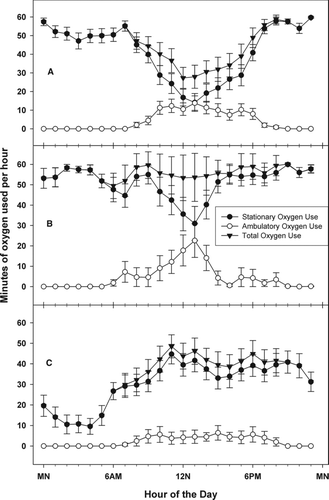
Figure 3. Compliance with long-term oxygen therapy over a 2-week period at baseline in 22 COPD patients. The abscissa divides each day into 1-hour bins (starting at midnight (MN)); the ordinate presents the average (± 1SE) minutes of use per hour for ambulatory, stationary and total oxygen use.
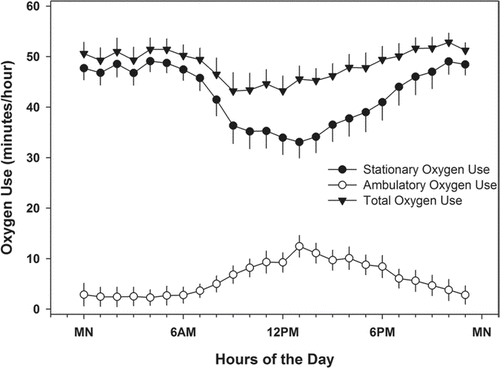
shows oxygen use prior to, and over the 6 months following, randomization. compares average oxygen use during baseline and post-randomization periods. Ambulatory oxygen use was higher at baseline in the lightweight than in the E-cylinder group (p = 0.04). In the lightweight group, ambulatory oxygen use was higher at baseline than in any subsequent month (p < 0.001). Oxygen use in the 2 groups was similar post-randomization; no significant differences were observed between groups or over time with respect to stationary, ambulatory or total oxygen use. Examination of individual records revealed that, following randomization, several subjects randomized to lightweight oxygen decreased ambulatory and increased stationary oxygen use (see Discussion).
Figure 4. Compliance with oxygen therapy in 22 COPD patients. Hours per day of oxygen use at baseline (BL) (during which ambulatory oxygen was delivered by E- cylinder) and over the 6 months post-randomization to ambulatory oxygen by either E-cylinder (n = 11) or lightweight cylinder (n = 11) are presented. Average (± 1SE) oxygen use for stationary, ambulatory and total oxygen use is plotted. *Significantly higher oxygen use than in E cylinder group at baseline (p = 0.04) and significantly higher oxygen use than in lightweight oxygen group during the intervention period (p < 0.001).
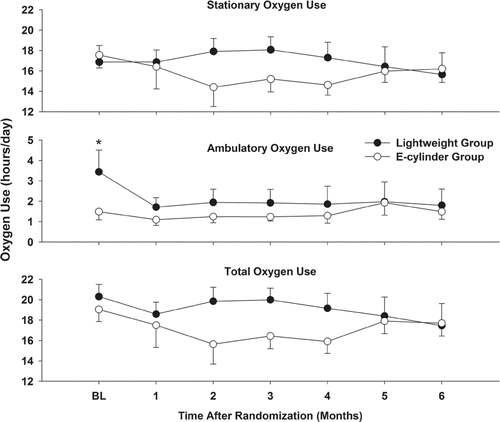
Table 3. Average hours per day of oxygen use at baseline and during the intervention period
Activity Level: presents daily activity time course in the two groups before and three and six months after randomization. The lower panel shows that during daytime hours monitors were worn ∼80% of the time; in each subject, each assessment period averaged ∼165 hours of recording time. Activity was highest mid-day and decreased in the evening. Activity profiles and wearing times were similar in the 2 groups and remained essentially unchanged during the intervention period. provides an overall summary; calculation of average mid-day activity (defined as 10AM–4PM) demonstrates that neither intervention engendered significant activity level alteration.
Figure 5. Time course of activity level and time worn over the course of the day at baseline, 3 months and 6 months in subjects in the E-cylinder and lightweight cylinder groups. The abscissa divides each day into one hour bins (starting at midnight (MN)). Left panels: subjects (n = 11) who used E-cylinders at baseline and lightweight cylinders after randomization for their ambulatory source. Right panels: subjects (n = 11) who used E-cylinders for their ambulatory source both at baseline and after randomization. Upper panels: activity levels (expressed as vector magnitude units (VMU)) assessed by tri-axial accelerometer. Lower panels: minutes the activity monitor was worn per hour for each hour of the day. X represents nighttime hours when wearing times in the group averaged <10 minutes/hour.
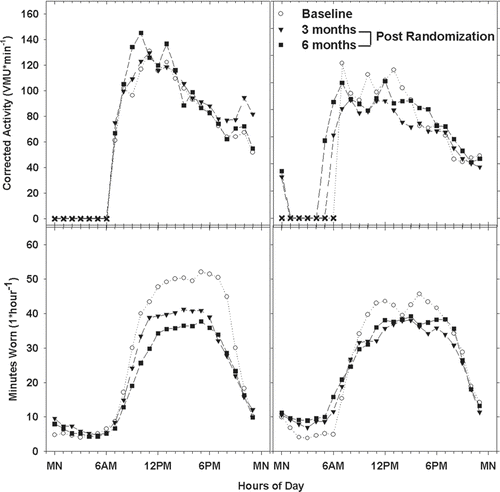
Table 4. Activity monitoring analysis at baseline and during the intervention period
We sought subject characteristics predictive of activity and oxygen use. At baseline, neither ambulatory nor stationary oxygen use correlated significantly with%predicted FEV1, DLCO, TLC, PaO2 or incremental exercise peak work rate. At baseline, mid-day activity did not correlate with %predicted FEV1, DLCO, PaO2 or incremental exercise peak work rate. Those with higher %predicted TLC had higher mid-day activity (r = 0.62, p = 0.0002). Higher stationary oxygen use correlated inversely with mid-day activity (r = –0.49, p = 0.02).
Discussion
Our central findings were that, in hypoxemic patients with severe COPD, use of ambulatory oxygen delivered by E-cylinders averaged only 2.5 hours/day, activity level was very low, and that no increase in oxygen utilization or activity was observed when lightweight ambulatory oxygen was provided.
Oxygen Compliance: Previously described methods for measuring oxygen compliance have discernable flaws:
Patient estimate via questionnaire or interview (Citation1, Citation11–15) often overestimates oxygen usage (Citation15). The present study confirms this: patient estimate of ambulatory oxygen use overestimated true use by 63% (Tables and ).
Utilizing stationary concentrator meter readings ignores the fact that patients often leave concentrators switched on when not wearing their nasal cannula. Also, nasal cannulae often become dislodged at night (Citation16).
Estimation of ambulatory oxygen use from number of compressed gas tanks emptied requires knowledge of oxygen pressure at the beginning and end of use and oxygen flow setting (which the patient may change at will).
Conserver devices makes accurate determination of oxygen therapy duration based on oxygen volume consumed impossible; when oxygen pulses are delivered with each breath, oxygen consumed is highly dependent on respiratory frequency.
The instrumentation we used allowed, for the first time, a comprehensive picture of oxygen use patterns. A key development was analysis routines allowing time alignment of stationary and ambulatory oxygen use, facilitating overall oxygen use characterization.
To our knowledge, no study assessing oxygen therapy compliance has been reported in a United States population since the 1980 NOTT study publication (Citation1). Dunne (Citation17) summarized overseas studies noting that only 26–55% of patients use LTOT for the hours/day prescribed. Although some evidence suggests that providing ambulatory oxygen is associated with increased oxygen use duration (Citation11, Citation14, Citation17), a substantial fraction of patients do not use ambulatory supplies outside their home. Further, a Canadian study estimated that patients provided ambulatory oxygen (in addition to a stationary source) used it only ∼15 min/day (Citation14).
In this study, baseline overall oxygen utilization averaged 19.7 hours/day, similar to the NOTT “continuous oxygen” group (Citation1). Ambulatory oxygen use was modest, averaging 2.5 hours/day at baseline and 1.7 hours/day following randomization. Of 22 subjects, 7 at baseline and 10 post-randomization used ambulatory oxygen <1 hour/day, use so limited that it is doubtful that appreciable benefit was conferred.
Baseline ambulatory oxygen use was greater in subjects later randomized to lightweight oxygen; after randomization, ambulatory oxygen use fell to a level similar to the E-cylinder group. Investigating this drop, we identified 4 subjects with substantial ambulatory oxygen use decrease. In 3 of 4 subjects, ambulatory oxygen decrease was not in mid-day hours and not accompanied by decreased activity level. We speculate that some subjects used E-cylinders as a stationary source within their home but did not use lightweight tanks in this way.
Activity Level: COPD patients with low activity levels (assessed by questionnaire) have poor survival (Citation18, 19). Activity monitors provide more precise assessment. Analyzing long-term tri-axial accelerometer recordings as we described previously (Citation4), demonstrated that subjects wore monitors roughly two-thirds of the time during mid-day hours, assuring good activity assessment. We previously determined (Citation4) that a healthy subject walking at 1 mph on a treadmill engenders a 290 VMU/min activity count, roughly 3 times higher than average daytime activity level recorded for these COPD patients, evidence of a sedentary lifestyle. Group assignment did not significantly alter mid-day activity over the 6-month observation period.
We can speculate as to why these patients did not increase oxygen use or activity level when provided with a more convenient ambulatory oxygen supply. A recent report identified several reasons why patients tend not to comply with ambulatory oxygen prescriptions (Citation20). Activity patterns involve ingrained habits; the permissive act of providing lightweight oxygen may not change behaviors. Perhaps coupling with a behavior modification intervention, such as pulmonary rehabilitation (Citation21), would be more successful.
An additional major finding is that 38% of subjects screened had resting PaO2 >60 torr. It is plausible that this is a manifestation of over-prescription and/or failure to recertify LTOT patients. Two Canadian and one French studies found that 30–40% of patients tested did not meet resting prescription criteria (Citation22–24). A small retrospective United States study contended that 60% of evaluated subjects could have oxygen discontinued (Citation25). In our study, we discerned no characteristics distinguishing qualifying from non-qualifying subjects (). Most subjects had been prescribed LTOT during hospitalization for COPD exacerbation and many denied subsequent re-evaluation. Strategies for re-assessing oxygen eligibility have been described (Citation26); our results suggest these strategies are underutilized.
Our study has several limitations. First, it was underpowered to test the primary endpoint of improving oxygen utilization. Accordingly, inability to find significant oxygen utilization difference between the two treatment groups may result from a type 2 error. However, patients randomized to lightweight oxygen decreased ambulatory oxygen use by 47% compared to when they used E-cylinders (P = 0.03). Data from a larger cohort would have to be remarkably different from what we observed to alter our conclusion. Second, our patients had low activity levels, had FEV1 averaging 36% predicted and had been receiving LTOT for >3 years. Our findings may not extrapolate to a less severe COPD population or when lightweight devices are provided with initial oxygen prescription.
Our provocative findings that LTOT patients use ambulatory oxygen only a few hours/day and perform little physical activity suggest several speculations: (a) inconvenience of using ambulatory oxygen may exceed its ability to relieve dyspnea, (b) the additional few hours of oxygen use obtainable with ambulatory devices may not improve LTOT survival benefits when average stationary use is 16–17 hours/day, (c) ambulatory device weight may not be important with respect to endpoints we studied, and (d) behavioral interventions, such as pulmonary rehabilitation, designed to encourage increased ambulatory oxygen use and activity levels, might be considered a necessary component of LTOT prescription.
Declaration of Interest
This study was funded by the COPD Clinical Research Network a 10-site network supported by a Cooperative Agreement (1U10 mechanism) from the National Heart, Lung, and Blood Institute; no funds from commercial sources were utilized. At some sites General Clinical Research Centers (GCRC) were utilized; their M01 grants from the National Center for Research Resources are listed. Members of this Network, with their personnel and grant support are: Brigham and Women's Hospital – J.J. Reilly, Jr. (PI), G. Washko, (Investigator), S. Peterson, C. Mayo (Coordinator), Grant HL074428, GCRC Grant RR02635; Denver Health Medical Center – R.K. Albert (PI), B. Make (Co-PI), C. Welsh (Investigators), M. Gilmartin, C. Verano (Coordinators), Grant HL074409, GCRC Grant RR00051; Los Angeles Biomedical Research Institute at Harbor-UCLA Medical Center – R. Casaburi (PI), J. Porszasz (Investigator), R.D. Love (Coordinator), Grant HL074407, GCRC Grant RR00425; Temple University – G.J. Criner (PI); W. Chatila, N. Marchetti, V. Kim, G D’Alonzo, S. Krachman, F. Cordova, K. Brennan, N. Patel, J. Mamary (Investigator), C. Grabianowski, N. Krayger, H. Criner (Coordinators), Grant HL074408; University of Alabama at Birmingham – W.C. Bailey, J.A.D. Cooper (Co-PIs), M.T. Dransfield, L.B Gerald, P. O’Reilly (Investigators), S. Tidwell (Coordinator), Grant HL074418; University of California, San Francisco – S.C. Lazarus (PI), H.A. Boushey, P.G. Woodruff (Investigators), R. Sakurai, C. Nguyen (Coordinators), Grant HL074431; University of Maryland, Baltimore – S.M. Scharf (PI), M.Alattar, P. Amelung, M. Cowan, J. Hanson, J. Hasday, A. Iacono, C. Shanholtz, N. Todd, A. Verceles (Investigators), W. Bell-Farrell, T. Fitzgerald, P. Wood (Coordinators), Grant HL074441, GCRC Grant RR16500; University of Michigan, Ann Arbor – F.J. Martinez (PI), J. Curtis, M.K. Han, P. Christensen (Investigators), K. Baptist, C. Flaherty, C. Getty, C. Jett, L. McCloskey, D. Thompson, D. White (Coordinators), Grant HL074422; University of Pittsburgh – F. Sciurba, (PI), R. Folger, D. Filippino (Coordinators), Grant HL074439, GCRC Grant RR00056; Minnesota Veterans Research Institute, Minneapolis – D.E. Niewoehner (PI), C. McEvoy, P.D. Scanlon, K.R. Rice (Co-PIs), C.B. Bourassa, P. Neuenfeldt (Coordinators), Grant HL074416. University of Minnesota (Data Coordinating Center) – J.E. Connett (PI), N.R. Anthonisen (Steering Committee Chair), C. Wendt (Co-PI), W. Patrek, H. Voelker, M. Skeans (Coordinators), Grant HL074424. Data and Safety Monitoring Board – B.B. Bender, S.F. Kelsey, J.R. Landis, B. Phillips, G.M. Turino, R. Veatch, A. Waldo, A. Wanner. Protocol Review Committee – H.W. Kelly, J. Maurer, A.J. McSweeny, R.M. Senior, E.A. Thom, P.D. Wagner, R.L. ZuWallack. NHLBI – G. Weinmann (Deputy Director, Division of Lung Diseases), T. Croxton (Director, Airway Biology & Disease Program), A. Punturieri, (Program Officer), M.P. Stylianou (Biostatistician).
Disclosures: R. Casaburi serves on the advisory board of Inogen, Inc. and as a consultant to Respironics, Inc. None of the other authors have conflicts of interest.
References
- Nocturnal Oxygen Therapy Trial Group. Continuous or nocturnal oxygen therapy in hypoxemic chronic obstructive lung disease: a clinical trial. Ann Intern Med 1980; 93:391–398.
- Medical Research Council Working Party. Long term domiciliary oxygen therapy in chronic hypoxic cor pulmonale complicating chronic bronchitis and emphysema. Report of the Medical Research Council Working Party. Lancet 1981; 1:681–686.
- Hankinson JL, Odencrantz JR, Fedan KB. Spirometric reference values from a sample of the general U.S. population. Am J Respir Crit Care Med 1999; 159:179–187.
- Hecht A, Ma S, Porszasz J, Casaburi R. Methodology for using long-term accelerometry monitoring to describe daily activity patterns in COPD. COPD 2009; 6:121–129.
- Miller MR, Hankinson J, Brusasco V, Standardisation of spirometry. Eur Respir J 2005; 26:319–338.
- Wanger J, Clausen JL, Coates A, Standardisation of the measurement of lung volumes. Eur Respir J 2005; 26:511–522.
- Macintyre N, Crapo RO, Viegi G, Standardisation of the single-breath determination of carbon monoxide uptake in the lung. Eur Respir J 2005; 26:720–735.
- Gorecka D, Gorzelak K, Sliwinski P, Tobiasz M, Zielinski J. Effect of long-term oxygen therapy on survival in patients with chronic obstructive pulmonary disease with moderate hypoxaemia. Thorax 1997; 52:674–679.
- Okubadejo AA, O’Shea L, Jones PW, Wedzicha JA. Home assessment of activities of daily living in patients with severe chronic obstructive pulmonary disease on long-term oxygen therapy. Eur Respir J 1997; 10:1572–1575.
- Pepin JL, Barjhoux CE, Deschaux C, Brambilla C. Long-term oxygen therapy at home. Compliance with medical prescription and effective use of therapy. ANTADIR Working Group on Oxygen Therapy. Association Nationale de Traitement a Domicile des Insuffisants Respiratories. Chest 1996; 109:1144–1150.
- Vergeret J, Brambilla C, Mounier L. Portable oxygen therapy: use and benefit in hypoxaemic COPD patients on long-term oxygen therapy. Eur Respir J 1989; 2:20–25.
- Clini E, Sturani C, Rossi A, The Italian multicentre study on noninvasive ventilation in chronic obstructive pulmonary disease patients. Eur Respir J 2002; 20:529–538.
- Kampelmacher MJ, Van Kesteren RG, Alsbach GP, Prescription and usage of long-term oxygen therapy in patients with chronic obstructive pulmonary disease in The Netherlands. Respir Med 1999; 93:46–51.
- Lacasse Y, Lecours R, Pelletier C, Begin R, Maltais F. Randomised trial of ambulatory oxygen in oxygen-dependent COPD. Eur Respir J 2005; 25:1032–1038.
- Walshaw MJ, Lim R, Evans CC, Hind CR. Factors influencing the compliance of patients using oxygen concentrators for long-term home oxygen therapy. Respir Med 1990; 84:331–333.
- Phillips GD, Harrison NK, Cummin AR, New method for measuring compliance with long term oxygen treatment. BMJ 1994; 308:1544–1545.
- Dunne PJ. The demographics and economics of long-term oxygen therapy. Respir Care 2000; 45:223–228; discussion 8–30.
- Garcia-Aymerich J, Felez MA, Escarrabill J, Physical activity and its determinants in severe chronic obstructive pulmonary disease. Med Sci Sports Exerc 2004; 36:1667–1673.
- Ringbaek TJ, Lange P. Outdoor activity and performance status as predictors of survival in hypoxaemic chronic obstructive pulmonary disease (COPD). Clin Rehabil 2005; 19:331–338.
- Arnold E, Bruton A, Donovan-Hall M, Fenwick A, Dibb B, Walker E. Ambulatory oxygen: why do COPD patients not use their portable systems as prescribed? A qualitative study. BMC Pulm Med 2011; 11:9.
- Pitta F, Troosters T, Probst VS, Langer D, Decramer M, Gosselink R. Are patients with COPD more active after pulmonary rehabilitation? Chest 2008; 134:273–280.
- Chaney JC, Jones K, Grathwohl K, Olivier KN. Implementation of an oxygen therapy clinic to manage users of long-term oxygen therapy. Chest 2002; 122:1661–1667.
- Guyatt GH, McKim DA, Austin P, Appropriateness of domiciliary oxygen delivery. Chest 2000; 118:1303–1308.
- Pelletier-Fleury N, Lanoe JL, Fleury B, Fardeau M. The cost of treating COPD patients with long-term oxygen therapy in a French population. Chest 1996; 110:411–416.
- Oba Y, Salzman GA, Willsie SK. Reevaluation of continuous oxygen therapy after initial prescription in patients with chronic obstructive pulmonary disease. Respir Care 2000; 45:401–46.
- Guyatt GH, Nonoyama M, Lacchetti C, A randomized trial of strategies for assessing eligibility for long-term domiciliary oxygen therapy. Am J Respir Crit Care Med 2005; 172:573–580.

